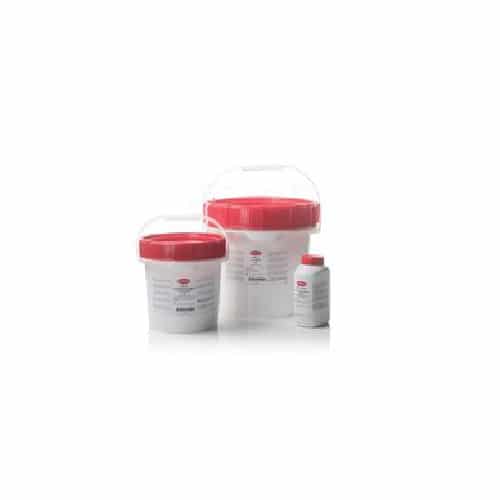
(M-CP) Agar Base 500g
RM1,539.00Brand:
Thermo ScientificTM OxoidTM
- Oxoid Membrane Clostridium Perfringens Agar Base (m-CP Agar Base) is a chromogenic medium for rapid isolation and presumptive identification of Clostridium perfringens from water samples.
- Also available: Membrane Clostridium Perfringens Selective Supplement, Part No. SR0188E.
Membrane Clostridium Perfringens (M-CP) Agar Base, Oxoid Composition
| Typical Formula * | gm/litre |
| Tryptose | 30.0 |
| Yeast extract | 20.0 |
| Sucrose | 5.0 |
| L-cysteine hydrochloride | 1.0 |
| Magnesium sulphate.7H2O | 0.1 |
| Agar | 15.0 |
| Bromocresol purple | 0.04 |
| pH 7.6 ± 0.2 @ 25°C |
(M-CP) Agar Base, Oxoid Preparation:
Suspend 35.55g of m-CP Agar Base in 500ml of distilled water Mix well and sterilise by autoclaving at 121°C for 15 minutes. Cool to 50°C and aseptically add the contents of one vial of m-CP Selective Supplement reconstituted as directed. Aseptically add the following sterile solutions dissolved in distilled water:
| Component | Solution Strength | Volume (ml) |
| Phenolphthalein biphosphate tetrasodium salt | 0.5% | 10.0 |
| Ferric chloride hexahydrate | 4.5% | 1.0 |
| Indoxyl b-D-glucoside | 0.75% | 4.0 |
Storage conditions and Shelf life
Store the dehydrated medium at 10-30°C and use before the expiry date on the label.
Prepared medium may be stored for up to 5 days at 2-8°C in the dark.
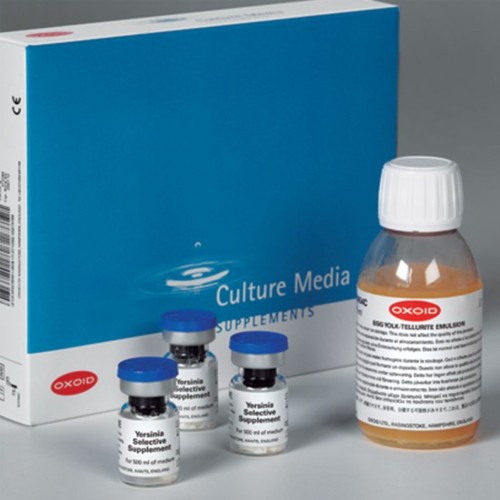
1M-Cp Selective Supplement
RM0.00Brand:
Thermo ScientificTM OxoidTM
Oxoid Membrane Clostridium Perfringens Selective Supplement (m-CP) is a chromogenic medium for rapid and presumptive identification of Clostridium perfringens from water samples.
- Add to Membrane Clostridium Perfringens (m-CP) Agar Base, Part No. CM0992B
- Each vial of SR0188E supplements 500mL of medium
1M-Cp Selective Supplement, Oxoid Composition
| Vial contents (each vial is sufficient for 500ml of medium) | per vial | per litre |
| Polymyxin B sulphate | 12.5mg | 25.0mg |
| D-Cycloserine | 200.0mg | 400.0mg |
1M-Cp Selective Supplement, Oxoid Preparation:
Suspend 35.55g of m-CP Agar Base in 500ml of distilled water Mix well and sterilise by autoclaving at 121°C for 15 minutes. Cool to 50°C and aseptically add the contents of one vial of m-CP Selective Supplement reconstituted as directed. Aseptically add the following sterile solutions dissolved in distilled water:
| Component | Solution Strength | Volume (ml) |
| Phenolphthalein biphosphate tetrasodium salt | 0.5% | 10.0 |
| Ferric chloride hexahydrate | 4.5% | 1.0 |
| Indoxyl b-D-glucoside | 0.75% | 4.0 |
Storage conditions and Shelf life
m-CP Selective Supplement SR0188 should be stored at 2-8°C.
Store the prepared medium at 2-8°C.
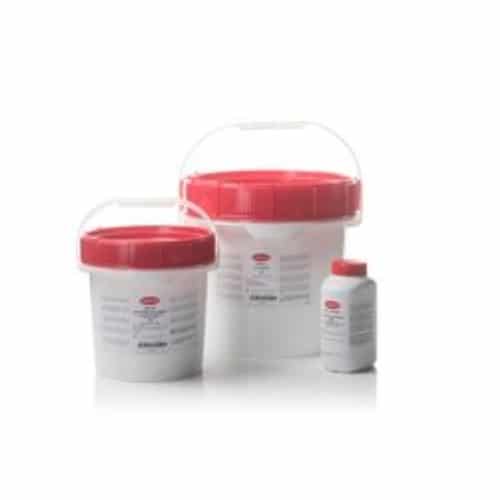
24 Leb Base 500g
RM809.00Brand:
Thermo ScientificTM OxoidTM
Selectively enrich Listeria monocytogenes and other Listeria spp. from food and environmental samples with Thermo Scientific™ Oxoid™ 24 Listeria Enrichment Broth (24 LEB) (Dehydrated). The medium provides optimal growing conditions for all Listeria species for PCR applications. It is specifically designed for use with PCR systems, such as Thermo Scientific™ SureTect™ molecular assays for Listeria.
24 LISTERIA ENRICHMENT BROTH (24 LEB), Oxoid Composition
| Typical Formula * | gm/litre |
| Peptone | 23.4 |
| Yeast extract | 5.0 |
| Lithium chloride | 10.0 |
| Ferric ammonium citrate | 0.1 |
| Sodium chloride | 5.0 |
| pH 7.4 ± 0.2 @ 25°C |
24 LISTERIA ENRICHMENT BROTH (24 LEB), Oxoid Preparation:
Completely dissolve 21.75g of 24 LEB Base per 500ml of distilled water. Sterilize by autoclaving at 121°C for 15 minutes. Cool to 50°C. Aseptically add the contents of 1 vial of 24 LEB Selective Supplement per 500ml medium, reconstituted as directed. Cool to room temperature before use, and, once made, store the medium at 2-8°C in the dark.

Aeromonas Med Base (Ryan) Supp 500g
RM0.00Brand:
Thermo ScientificTM OxoidTM
- Oxoid Aeromonas Medium Base (Ryan) is a selective differential medium for the isolation of Aeromonas hydrophila.
- Also available Ampicillin Selective Supplement, Part No. SR0136E.
Aeromonas Medium Base (Ryan), Oxoid Composition
| Typical Formula * | gm/litre |
| Proteose peptone | 5.0 |
| Yeast extract | 3.0 |
| L. Lysine monohydrochloride | 3.5 |
| L. Arginine monohydrochloride | 2.0 |
| Sorbitol | 3.0 |
| Inositol | 2.5 |
| Lactose | 1.5 |
| Xylose | 3.75 |
| Bile Salts No.3 | 3.0 |
| Sodium thiosulphate | 10.67 |
| Sodium chloride | 5.0 |
| Ferric ammonium citrate | 0.8 |
| Bromothymol blue | 0.04 |
| Thymol blue | 0.04 |
| Agar | 12.5 |
| pH 8.0 ± 0.2 @ 25°C |
Aeromonas Medium Base (Ryan), Oxoid Preparation:
Suspend 29.5g in 500ml of distilled water. Bring gently to the boil. DO NOT AUTOCLAVE. Cool to 50°C and aseptically add one vial of Ampicillin Selective Supplement SR0136 reconsituted as directed. Mix well and pour plates.
Storage conditions and Shelf life
Store the dehydrated medium at 10-30°C and use before the expiry date on the label.
Store the prepared plates of medium 2-8°C.
Precautions
Although Aeromonas and Plesiomonas spp will grow on the medium if ampicillin is omitted, it will be more difficult to distinguish them from the other organisms present on the plate. Suspected colonies of Aeromonas spp must be confirmed by biochemical tests.

AFPA Base 500g
RM0.00Brand:
Thermo ScientificTM OxoidTM
- Oxoid AFPA Medium Base is a selective identification medium for the detection of Aspergillus flavus and Aspergillus parasiticus.
- Also available: Membrane Clostridium Perfringens Selective Supplement, Part No. SR0188E.
AFPA Medium Base, Oxoid Composition
| Typical Formula * | gm/litre |
| Peptone | 10.0 |
| Yeast extract | 20.0 |
| Ferric ammonium Citrate | 0.5 |
| Dichloran | 0.002 |
| Agar | 15.0 |
| pH 6.3 ± 0.2 @ 25°C |
AFPA Medium Base, Oxoid Preparation:
Suspend 22.75g in 500ml (45.5g/l) of distilled water and heat to dissolve completely. Reconstitute one vial SR0078E per 500ml medium or one vial SR0078H per 2 litres medium, as directed. Add the vial contents to the AFPA Base. Sterilise by autoclaving at 121°C for 15 minutes. Cool to 50°C. Mix well and pour into sterile Petri dishes.
Storage conditions and Shelf life
Store the dehydrated medium at 10-30°C and use before the expiry date on the label.
Store the prepared plates at 2-8°C.
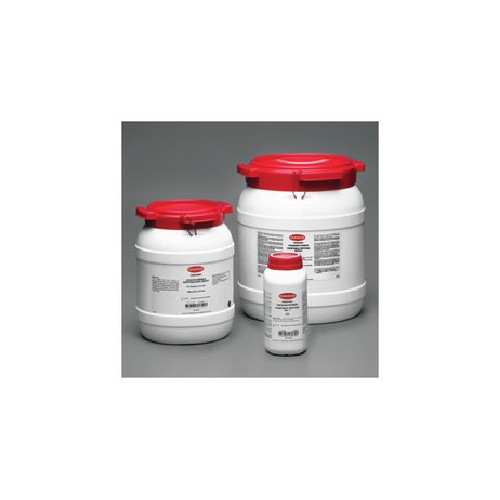
Agar Bacteriological (Agar No.1) 500g, Oxoid
RM484.00Brand:
Thermo ScientificTM OxoidTM
Agar Bacteriological (Agar No. 1, Oxoid) is a clear purified high gel strength bacteriological agar compatible with all culture media. This agar has low calcium (Ca) and magnesium (Mg) levels and has very high working gel strength (1.5% w/v).
Agar Bacteriological, Oxoid is compatible with all culture media. It can be formulated to either broth or agar of the same medium with very similar metal values. This characteristic is especially valuable in antimicrobial MIC studies where differences in mineral/metal content can profoundly influence the results. Due to the low mineral/metal content in Agar Bacteriological, Oxoid, it allows free diffusion of antimicrobial substances. As a result, it is a highly satisfactory agar for antimicrobial diffusion studies (disc diffusion susceptibility tests).
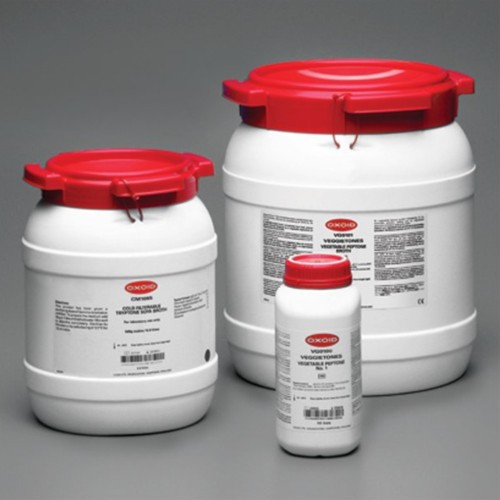
Agar Technical (Agar No 3) 500g
RM0.00Brand:
Thermo ScientificTM OxoidTM
**This product is not available at the moment. Please contact us for more information.
Oxoid Agar Technical (Agar No. 3) is a technical grade, high working gel strength agar (1.2% w/v) suitable for purposes where clarity and compatibility are not of prime importance or where the high mineral/metal content has cultural advantages.

Alkaline Peptone Water (ISO) 500g
RM328.00Brand:
Thermo ScientificTM OxoidTM
Enrich and recover Vibrio species from food and water samples with Thermo Scientific™ Oxoid™ Alkaline Saline Peptone Water (ISO) (Dehydrated), while adhering to ISO/TS 21872-1&2:2007. This medium is selective by exploiting the ability of Vibrio species to tolerate alkaline conditions and high sodium chloride levels. The peptone content provides the conditions for growth and recovery of Vibrio species, supplying vitamins, minerals, and nitrogen in the form of amino acids.
Alkaline Saline Peptone Water (ISO), Oxoid Composition
| Typical Formula * | gm/litre |
| Peptone | 20.0 |
| Sodium chloride | 20.0 |
| pH 6.6 ± 0.2 @ 25°C |
Alkaline Saline Peptone Water (ISO), Oxoid Preparation:
Dissolve 40g in 1 litre of distilled water. Mix well and distribute into final containers. Sterilize by autoclaving at 121°C for 15 minutes.

Alkaline Peptone Water 500g
RM262.00Brand:
Thermo ScientificTM OxoidTM
Enrich and recover Vibrio species from food, water, and clinical samples with Thermo Scientific™ Oxoid™ Alkaline Peptone Water. This medium is selective by exploiting the ability of Vibrio species to tolerate alkaline conditions and high sodium chloride levels. The peptone content provides the conditions for growth and recovery of Vibrio species, supplying vitamins, minerals, and nitrogen in the form of amino acids.
Alkaline Saline Peptone Water, Oxoid Composition
| Typical Formula * | gm/litre |
| Peptone | 10.0 |
| Sodium chloride | 20.0 |
| pH 6.6 ± 0.2 @ 25°C |
Alkaline Saline Peptone Water, Oxoid Preparation:
Add 30g to 1 litre of distilled water. Mix well, distribute into final containers and sterilize by autoclaving at 121°C for 15 minutes.
Storage conditions and Shelf life
The dehydrated medium should be stored at 10-30°C and used before the expiry date on the label.
Store the prepared medium may be stored for up to 1 month at room temperature.

Ampicillin Selective Supplement 1 x 10 Vials
RM479.00Brand:
Thermo ScientificTM OxoidTM
- Oxoid Ampicillin Selective Supplement is used for the isolation of Aeromonas hydrophila.
- Add to to Aeromonas Medium Base, Part No. CM0833B.
Ampicillin Selective Supplement, Oxoid Preparation:
Suspend 29.5g in 500ml of distilled water. Bring gently to the boil. DO NOT AUTOCLAVE. Cool to 50°C and aseptically add one vial of Ampicillin Selective Supplement SR0136 reconsituted as directed. Mix well and pour plates.
| Vial contents (each vial is sufficient for 500 ml of medium) | per vial | per litre |
| Ampicillin | 2.5mg | 5.0mg |
Storage conditions and Shelf life
Store the dehydrated medium at 10-30°C and use before the expiry date on the label.
Store the prepared plates of medium 2-8°C.

Anaerobe Basal Agar 500g
RM715.00Brand:
Thermo ScientificTM OxoidTM
- Oxoid Anaerobe Basal Agar is used for growth of fastidious and other anaerobes.
- Also available N-S Anaerobe Selective Supplement, Part No. SR0107B, for use for nonsporforming anaerobes and G-N Anaerobe Selective Supplement, Part No. SR0108B, for use for gram-negative anaerobes.
Anaerobe Basal Agar, Oxoid Composition
| Typical Formula * | gm/litre |
| Peptone | 16.0 |
| Yeast extract | 7.0 |
| Sodium chloride | 5.0 |
| Starch | 1.0 |
| Dextrose | 1.0 |
| Sodium pyruvate | 1.0 |
| Arginine | 1.0 |
| Sodium succinate | 0.5 |
| L-cysteine HCl | 0.25 |
| Sodium bicarbonate | 0.4 |
| Ferric pyrophosphate | 0.5 |
| Haemin | 0.005 |
| Vitamin K | 0.0005 |
| Dithiothreitol | 0.25 |
| Agar | 12.0 |
| pH 6.8 ± 0.2 @ 25°C |
Anaerobe Basal Agar, Oxoid Preparation:
Suspend 46g in 1 litre of distilled water. Sterilise by autoclaving at 121°C for 15 minutes. Cool to 50-55°C and aseptically add 5-10% sterile Defibrinated Horse Blood SR0050.
Storage conditions and Shelf life
Store the dehydrated medium at 10-30°C and use before the expiry date on the label.
Store the prepared plates of medium for upto 3 weeks at 2-8°C.

Anaerobe Basal Broth 500g
RM2,615.00Brand:
Thermo ScientificTM OxoidTM
Cultivate anaerobic microorganisms, particularly Bacteroides spp. and other fastidious anaerobes with Thermo Scientific™ Oxoid™ Anaerobe Basal Agar (Dehydrated). Anaerobe Basal Broth is formulated from a range of nutrients which have been selected to optimize the recovery and growth of the majority of anaerobic organisms of clinical importance.
Anaerobe Basal Broth, Oxoid Composition
| Typical Formula * | gm/litre |
| Peptone | 16.0 |
| Yeast extract | 7.0 |
| Sodium chloride | 5.0 |
| Starch | 1.0 |
| Dextrose | 1.0 |
| Sodium pyruvate | 1.0 |
| Arginine | 1.0 |
| Sodium succinate | 0.5 |
| L-cysteine HCl | 0.25 |
| Sodium bicarbonate | 0.4 |
| Ferric pyrophosphate | 0.5 |
| Haemin | 0.005 |
| Vitamin K | 0.0005 |
| Dithiothreitol | 0.25 |
| Agar | 12.0 |
| pH 6.8 ± 0.2 @ 25°C |
Anaerobe Basal Broth, Oxoid Preparation:
Suspend 35.4g of Anaerobe Basal Broth in 1 litre of distilled water. Bring to the boil to dissolve. Distribute into final containers. Sterilise by autoclaving at 121°C for 15 minutes.
Storage conditions and Shelf life
Anaerobe Basal Broth should be stored tightly capped in the original container at 10-30°C. When stored as directed, the medium will remain stable until the expiry date printed on the label.

Andrades Peptone Water 500g
RM430.00Brand:
Thermo ScientificTM OxoidTM
This product has been discontinued. The alternative to this product is Peptone Water.
Oxoid Peptone Water Andrade’s is a nutrient base containing Andrade’s indicator to which carbohydrates and other diagnostic reagents may be added for use in fermentation studies.
Peptone Water Andrade’s, Oxoid Composition
| Typical Formula * | gm/litre |
| Peptone | 10.0 |
| Sodium chloride | 5.0 |
| Andrade’s Indicator (acid-Fuchsin) | 0.1 |
| pH 7.4 ± 0.2 @ 25°C |
Peptone Water Andrade’s, Oxoid Preparation:
Suspend 15 g in 1 litre of distilled water. Mix well to dissolve, distribute into tubes or bottles, containing Durham tubes and sterilize by autoclaving at 121°C for 15 minutes.
Storage conditions and Shelf life
Store the dehydrated medium at 10-30°C and use before the expiry date on the label.
Store the prepared medium in the dark at room temperature.

Arcobacter Broth 500g
RM1,098.00Brand:
Thermo ScientificTM OxoidTM
- Oxoid Arcobacter Broth Base is used for the selective growth of Arcobacter spp.
- Also available CAT Supplement, Part No. SR0174E and CCDA Selective Supplement, Part No. SR0155E and SR0155H.
Arcobacter Broth Base, Oxoid Composition
| Typical Formula * | gm/litre |
| Peptone | 18.0 |
| Yeast extract | 1.0 |
| Sodium chloride | 5.0 |
| pH 7.2 ± 0.2 @ 25°C |
Arcobacter Broth Base, Oxoid Preparation:
Dissolve 12g of Arcobacter Broth in 500ml of distilled water. Sterilise at 121°C for 15 minutes and allow to cool to below 50°C
For use with CAT supplement (SR0174)
Add one vial per 500ml medium of CAT Selective Supplement reconstituted as directed. Dispense into sterile containers.
For use with CCDA supplement (SR0155)
Add one vial per 500ml medium of CCDA Selective Supplement reconstituted as directed. Dispense into sterile containers.
Inoculated plates should be incubated aerobically, at 30°C, for 24 hours.
Storage conditions and Shelf life
Store the dehydrated medium at 10-30°C and use before the expiry date on the label.

Azide Blood Agar Base 500g
RM914.00Brand:
Thermo ScientificTM OxoidTM
Oxoid Azide Blood Agar Base is a selective media for the detection and isolation of streptococci and staphylococci from feces, sewage and other specimens.
Azide Blood Agar Base, Oxoid Composition
| Typical Formula * | gm/litre |
| Tryptose | 10.0 |
| `Lab-Lemco’ powder | 3.0 |
| Sodium chloride | 5.0 |
| Sodium azide | 0.2 |
| Agar | 12.0 |
| pH 7.2 ± 0.2 @ 25°C |
Azide Blood Agar Base Oxoid Preparation:
Suspend 30g in 1 litre of distilled water and bring to the boil to dissolve completely. Sterilise by autoclaving at 121°C for 15 minutes. For azide blood agar, cool to 45-50°C and add 5% of sterile blood.
Storage conditions and Shelf life
Store the dehydrated medium at 10-30°C and use before the expiry date on the label.
Store prepared blood agar plates of medium at 2-8°C.
Precautions
Proteus and Escherichia species may not always be inhibited on the Edward’s formulation.
Always use a light inoculum for best selective results.
Anaerobic incubation will enhance haemolytic reactions.
Haemolytic reactions will not be typical on Packer’s modification of Azide Blood Agar Base. Streptococcus lactis will not grow on Packer’s modification with 5% sheep blood.
Read the section on Hazard Precautions for azide-containing media.

Azide Dextrose Broth (Rothe) 500g
RM1,040.00Brand:
Thermo ScientificTM OxoidTM
Oxoid Azide Dextrose Broth (Rothe Broth) is used for the detection of enterococciin water, sewage, and food.
Azide Dextrose Broth (Rothe Broth), Oxoid Composition
| Typical Formula * | gm/litre |
| Peptone | 20.0 |
| Glucose | 5.0 |
| Sodium chloride | 5.0 |
| Di-potassium hydrogen phosphate | 2.7 |
| Potassium dihydrogen phosphate | 2.7 |
| Sodium azide | 0.2 |
| pH 6.8 ± 0.2 @ 25°C |
Azide Dextrose Broth (Rothe Broth), Oxoid Preparation:
Add 35.6g to one litre of distilled water for single strength broth or 71.2g for double strength broth. Heat gently to dissolve. Dispense into final containers and sterilise by autoclaving at 121°C for 15 minutes.
Storage conditions and Shelf life
Store the dehydrated medium at 10-30°C and use before the expiry date on the label.
Store the prepared medium at 2-8°C.
Precautions
This product contains less than 1% azide and has low toxicity. However, when handling the powder, wear gloves, mask and eye protection. When washing azide products down sinks, use sufficient water to prevent accumulation of azide in the plumbing.
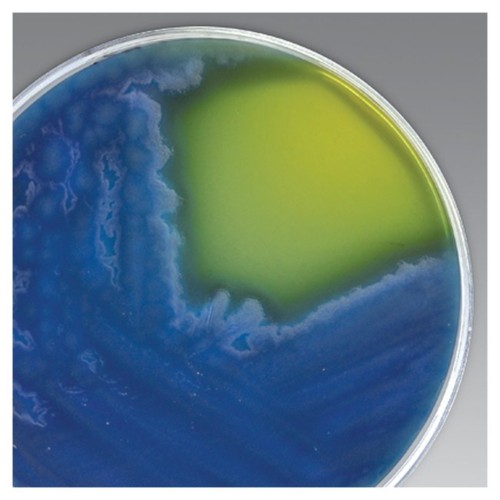
Bacillus Cereus Select Agar Base 500g
RM528.00Brand:
Thermo ScientificTM OxoidTM
Selectively isolate and enumerate Bacillus cereus from food samples with Thermo Scientific™ Oxoid™ Bacillus cereus Selective Agar Base (Dehydrated). Bacillus cereus Selective Agar Base meets the requirements for a medium that is sufficiently selective to be able to detect small numbers of Bacillus cereus cells and spores in the presence of large numbers of other food contaminants. The medium is also sufficiently diagnostic that colonies of Bacillus cereus are readily identified and confirmed by microscopic examination.
Bacillus cereus Selective Agar Base, Oxoid Composition
| Typical Formula * | gm/litre |
| Peptone | 1.0 |
| Mannitol | 10.0 |
| Sodium chloride | 2.0 |
| Magnesium sulphate | 0.1 |
| Disodium hydrogen phosphate | 2.5 |
| Potassium dihydrogen phosphate | 0.25 |
| Bromothymol blue | 0.12 |
| Sodium pyruvate | 10.0 |
| Agar | 15.0 |
| pH 7.2 ± 0.2 @ 25°C |
Bacillus cereus Selective Agar Base, Oxoid Preparation:
Suspend 20.5g in 475ml of distilled water and bring gently to the boil to dissolve completely. Sterilise by autoclaving at 121°C for 15 minutes. Cool to 50°C and aseptically add the contents of one vial of Polymyxin B Supplement (SR0099) reconstituted as directed, then add 25ml of sterile Egg Yolk Emulsion (SR0047). Mix well and pour into sterile Petri dishes.
Storage conditions and Shelf life
Store the dehydrated medium at 10-30°C and Polymixin B Supplement at 2-8°C. Use before the expiry date on the label.
The prepared medium may be stored at 2-8°C.
Precautions
On this medium Bacillus cereus is indistinguishable from Bacillus thuringiensis.
Identify Bacillus cereus by colony form, colour, egg yolk hydrolysis and confirm with cell and spore morphology.
Occasional strains of Bacillus cereus show weak or negative egg yolk reactions.

Baird Parker Agar Base 500g, Oxoid
RM400.00Brand:
Thermo ScientificTM OxoidTM
Baird Parker Agar Base, Oxoid is suitable for the isolation and enumeration of Staphylococcus aureus, with high selectivity and sensitivity. It contains carefully balanced selective inhibitory agents, glycine, lithium, and tellurite, to suppress the growth of most of the bacteria present in foods without inhibiting coagulase-positive staphylococci. The presence of egg yolk emulsion and sodium pyruvate aid the recovery of damaged cells for presumptive identification of Staphylococcus aureus in food specimens.
| Typical Formula * | gm/litre |
| Pancreatic digest of casein | 10.0 |
| Meat extract | 5.0 |
| Sodium pyruvate | 10.0 |
| Yeast extract | 1.0 |
| Glycine | 12.0 |
| Lithium chloride | 5.0 |
| Agar | 20.0 |
| pH 7.2 ± 0.2 @ 25°C |
Baird Parker Agar Base, Oxoid Preparation:
Suspend 6.3g of Baird-Parker Agar Base (RPF) in 90ml of distilled water. Bring to the boil to dissolve completely. Sterilise by autoclaving at 121ºC for 15 minutes. Cool to 48ºC and add 1 vial of RPF Supplement (SR0122A), reconstituted as directed. Mix well and pour plates.
Storage Conditions and Shelf Life
Store the dehydrated medium at 10-30°C and RPF Supplement below 0°C. Use before the expiry date on the label.
Prepared plates of the medium are best used freshly prepared.
Precautions
Regard all suspicious colonies as Staphylococcus aureus regardless of negative reactions in the medium and carry out further tests.
Colonies of some contaminating organisms growing in close proximity to the coagulase positive colonies may partially digest the coagulase halo reaction.

Baird-Parker Agar (ISO) 500g
RM604.00Brand:
Thermo ScientificTM OxoidTM
Isolate, enumerate, and identify coagulase positive Staphylococcus aureus in food samples with selective Thermo Scientific™ Oxoid™ Baird Parker Agar (ISO) Base (Dehydrated) while adhering to ISO 6888-1:1999.
Baird Parker Agar (ISO) Base, Oxoid Composition
| Typical Formula* | gm / litre |
| Pancreatic digest of casein | 10.0 |
| Meat extract | 5.0 |
| Yeast extract | 1.0 |
| Sodium pyruvate | 10.0 |
| L-glycine | 12.0 |
| Lithium chloride | 5.0 |
| Agar | 20.0 |
| pH 7.2 ± 0.2 @ 25°C |
Baird Parker Agar (ISO) Base, Oxoid Preparation:
Suspend 63g of Baird-Parker Agar (ISO) Base in 1,000ml of distilled water. Boil to dissolve the medium and sterilise by autoclaving at 121°C for 15 minutes. Cool to 47°C and aseptically add 50ml of Egg Yolk Tellurite Emulsion (SR0054). Mix well and pour into sterile Petri dishes.
Storage conditions and Shelf life
Store the dehydrated medium at 10-30°C and use before the expiry date on the label.
The prepared medium is best used freshly prepared, but may be suitable for longer storage following in-house validation.
Precautions
Atypical colonies have the same size as typical colonies but can be shining black with or without a narrow white edge; the clear zone or opacity halo can also be absent or barely visible. Grey colonies, free of clear zone, can also be regarded as atypical.
Regard all typical and atypical colonies as coagulase-positive staphylococci irrespective of negative reactions on the medium and carry out further tests.
Colonies of some contaminating organisms growing in close proximity to the coagulase positive colonies may partially digest the coagulase halo reaction.

Baird-Parker Agar Base (Modified) 500g
RM494.00Brand:
Thermo ScientificTM OxoidTM
- The Oxoid Baird-Parker RPF Agar Base is a selective medium for the isolation and enumeration of coagulase positive staphylococci from food.
- For use with RPF supplement, Part No. SR0122A
- Do not use Egg Yolk Tellurite Emulsion.
Baird-Parker Agar Base (RPF), Oxoid Composition
| Typical Formula* | gm/litre |
| Pancreatic digest of casein | 10.0 |
| Meat extract | 5.0 |
| Sodium pyruvate | 10.0 |
| Yeast extract | 1.0 |
| Glycine | 12.0 |
| Lithium chloride | 5.0 |
| Agar | 20.0 |
| pH 7.2 ± 0.2 @ 25ºC |
Baird-Parker Agar Base (RPF), Oxoid Preparation:
Suspend 6.3g of Baird-Parker Agar Base (RPF) in 90ml of distilled water. Bring to the boil to dissolve completely. Sterilise by autoclaving at 121ºC for 15 minutes. Cool to 48ºC and add 1 vial of SR0122A, reconstituted as directed. Mix well and pour plates.
Storage conditions and Shelf life
Store the dehydrated medium at 10-30°C and RPF Supplement below 0°C. Use before the expiry date on the label.
Prepared plates of medium are best used freshly prepared.
Precautions
Colonies of some contaminating organisms growing in close proximity to the coagulase positive colonies may partially digest the coagulase halo reaction.

Basic Fuchsin – Technical Dye (10G)
RM0.00Brand:
Thermo ScientificTM OxoidTM
Oxoid Basic Fuchsin Indicator is a dye for use with Endo Agar Base, Part No. CM0479B and m Endo (LES) Agar Base, Part No. MM0551B.
Basic Fuchsin Preparation:
BR0050 should be dissolved to create a 10% w/v solution using 95% ethyl alcohol.
For each litre of culture medium use the amount described in the product reconstitution details. This should be in a 10% w/v solution of the dye dissolved in 50:50 ethanol/distilled water. E.g. For CM0479 add 6ml of a 10% w/v Basic Fuchsin solution per litre of medium.
The magenta dyes are closely related to known carcinogenic substances; therefore basic fuchsin should be handled with care, avoiding inhaling the powder or staining the skin with dye.

Biggy Agar 500g
RM1,013.00Brand:
Thermo ScientificTM OxoidTM
Oxoid BiGGY Agar (Nickerson Medium) for the isolation and presumptive identification of Candida spp.
BiGGY Agar, Oxoid Composition
| Typical Formula* | gm/litre |
| Yeast extract | 1.0 |
| Glycine | 10.0 |
| Glucose | 10.0 |
| Sodium sulphite | 3.0 |
| Bismuth ammonium citrate | 5.0 |
| Agar | 13.0 |
| pH 6.8 ± 0.2 @ 25°C |
BiGGY Agar, Oxoid Preparation:
Suspend 42g in 1 litre of distilled water and bring gently to the boil to dissolve the agar. Allow to cool to 50-55°C. Mix gently to disperse the flocculant precipitate and pour into sterile Petri dishes.
DO NOT AUTOCLAVE THE MEDIUM.
Storage conditions and Shelf life
Store the dehydrated medium at 10-30°C and use before the expiry date on the label.
Medium should be freshly prepared just prior to use.
Precautions
Carry out further tests to confirm identity of isolated yeasts.
Do not use slants of medium because the reactions are unsatisfactory.
The flocculent precipitate present in the molten medium must be evenly suspended whilst dispensing the agar.

Bile Aesculin Agar 500g
RM1,380.00Brand:
Thermo ScientificTM OxoidTM
Isolate and presumptively identify enterococci / Group D streptococci with Thermo Scientific™ Oxoid™ Bile Aesculin Agar (Dehydrated). Bile Aesculin Agar is designed to differentiate between Group D streptococci and non-Group D streptococci.
Group D streptococci hydrolyse aesculin to form aesculetin and dextrose. Aesculin hydrolysis is indicative of a positive result. Bile salts in the medium inhibit Gram-positive bacteria other than enterococci/ Group D streptococci.
Bile Aesculin Agar, Oxoid Composition
| Typical Formula* | gm/litre |
| Peptone | 14.0 |
| Bile salts | 15.0 |
| Ferric citrate | 0.5 |
| Aesculin | 1.0 |
| Agar | 15.0 |
| pH 7.1 ± 0.2 @ 25°C |
Bile Aesculin Agar, Oxoid Preparation:
Suspend 44.5g in 1 litre of distilled water and bring gently to the boil to dissolve completely. Sterilise by autoclaving at 121°C for 15 minutes.
Storage conditions and Shelf life
Store the dehydrated medium at 10-30°C and use before the expiry date on the label.

Bile Salts 250g
RM832.00Brand:
Thermo ScientificTM OxoidTM
Oxoid Bile Salts is a standardized ox-bile extract used as a selective inhibitory agent in culture media.



